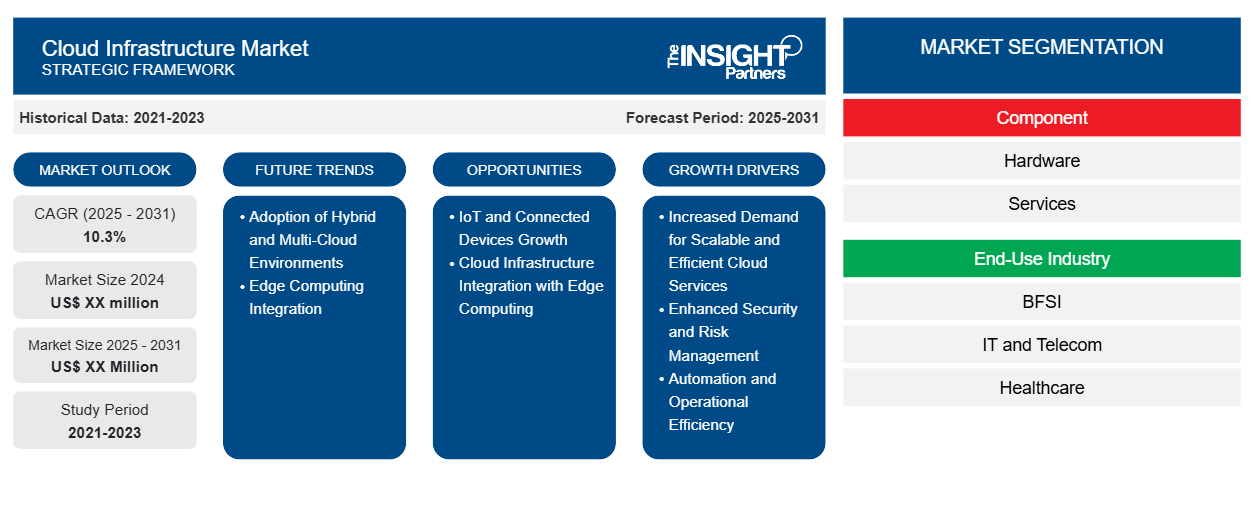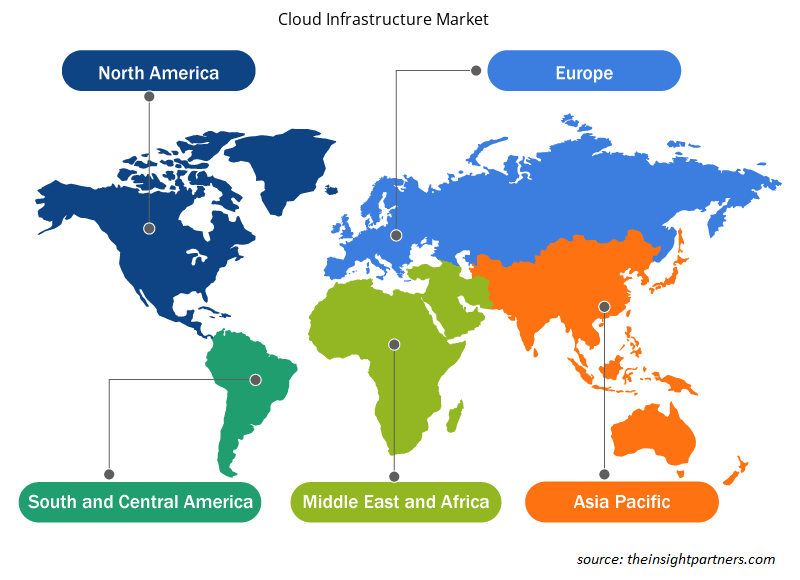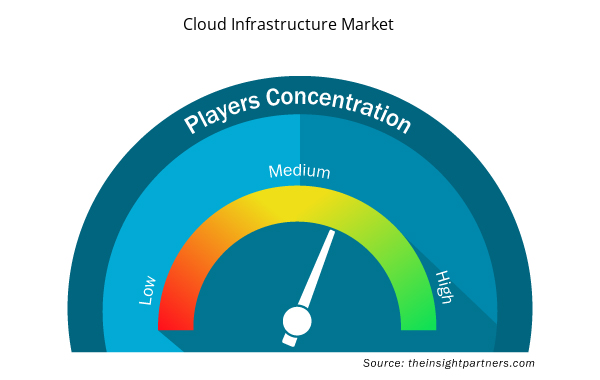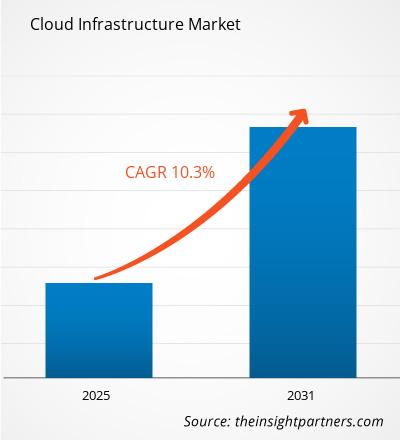The Cloud Infrastructure Market is expected to register a CAGR of 10.3% from 2025 to 2031, with a market size expanding from US$ XX million in 2024 to US$ XX Million by 2031.
The report is segmented by Component (Hardware, Services); End-Use Industry (BFSI, IT and Telecom, Healthcare, Government, Retail, Manufacturing, Media and Entertainment, Others). The global analysis is further broken-down at regional level and major countries. The report offers the value in USD for the above analysis and segments
Purpose of the Report
The report Cloud Infrastructure Market by The Insight Partners aims to describe the present landscape and future growth, top driving factors, challenges, and opportunities. This will provide insights to various business stakeholders, such as:
- Technology Providers/Manufacturers: To understand the evolving market dynamics and know the potential growth opportunities, enabling them to make informed strategic decisions.
- Investors: To conduct a comprehensive trend analysis regarding the market growth rate, market financial projections, and opportunities that exist across the value chain.
- Regulatory bodies: To regulate policies and police activities in the market with the aim of minimizing abuse, preserving investor trust and confidence, and upholding the integrity and stability of the market.
Cloud Infrastructure Market Segmentation
Component
- Hardware
- Services
End-Use Industry
- BFSI
- IT and Telecom
- Healthcare
- Government
- Retail
- Manufacturing
- Media and Entertainment
Customize This Report To Suit Your Requirement
You will get customization on any report - free of charge - including parts of this report, or country-level analysis, Excel Data pack, as well as avail great offers and discounts for start-ups & universities
Cloud Infrastructure Market: Strategic Insights

- Get Top Key Market Trends of this report.This FREE sample will include data analysis, ranging from market trends to estimates and forecasts.
Cloud Infrastructure Market Growth Drivers
- Increased Demand for Scalable and Efficient Cloud Services: As businesses continue to adopt cloud-based solutions, there is a growing need for scalable, efficient, and cost-effective cloud infrastructure. AI plays a vital role in optimizing cloud operations by automating resource management, workload balancing, and predictive maintenance. AI-driven systems can analyze usage patterns to dynamically allocate resources, ensuring that cloud services are always optimized for performance and cost. This capability to scale and optimize infrastructure is one of the primary drivers for the integration of AI in the cloud infrastructure market.
- Enhanced Security and Risk Management: The increasing complexity and frequency of cyber threats are pushing organizations to prioritize cloud security. AI enables advanced threat detection, anomaly detection, and automated incident response within cloud environments. AI-powered security solutions can quickly identify vulnerabilities, predict potential attacks, and take preventive actions in real-time. This enhancement in security measures is crucial for businesses adopting cloud infrastructure, making AI a key driver for the growth of the AI in cloud infrastructure market.
- Automation and Operational Efficiency: AI technologies, particularly machine learning and deep learning, are improving the automation of cloud infrastructure management, reducing the need for manual intervention and improving operational efficiency. AI can predict system failures, optimize workflows, and automate routine tasks such as patching, updates, and backups. This automation leads to faster and more reliable cloud operations, reducing human error and operational costs. The ability to enhance productivity and streamline infrastructure management is a significant driver for the adoption of AI in cloud infrastructure.
Cloud Infrastructure Market Future Trends
- Adoption of Hybrid and Multi-Cloud Environments: As organizations seek to optimize their cloud strategies, the adoption of hybrid and multi-cloud environments will continue to grow. Businesses are increasingly leveraging a combination of private, public, and edge clouds to avoid vendor lock-in, enhance performance, and ensure compliance with regional data regulations. Hybrid and multi-cloud approaches allow businesses to distribute workloads across various cloud providers, improving flexibility and redundancy. This trend will drive the development of more sophisticated tools for cloud management, orchestration, and automation to help businesses seamlessly manage workloads across multiple cloud platforms.
- Edge Computing Integration: With the growing demand for real-time data processing and low-latency applications, edge computing will become a key component of cloud infrastructure. Edge computing allows data to be processed closer to the source of generation (e.g., IoT devices, sensors, or autonomous vehicles), reducing latency and bandwidth consumption. The integration of edge computing with cloud infrastructure will enable faster processing of large volumes of data in industries such as healthcare, manufacturing, and smart cities. As 5G networks become more widespread, the synergy between cloud infrastructure and edge computing will be critical for supporting applications that require high-speed, low-latency processing.
Cloud Infrastructure Market Opportunities
- IoT and Connected Devices Growth: The vast growth in IoT devices is a good reason for developing cloud infrastructure to manage high data processing and storage needs, providing large growth opportunities for cloud service providers.
- Cloud Infrastructure Integration with Edge Computing: Cloud infrastructure integration with edge computing offers faster processing at the source, and applications such as real-time services in the healthcare and manufacturing industries, along with autonomous vehicles, create new market opportunities.
Cloud Infrastructure Market Regional Insights
The regional trends and factors influencing the Cloud Infrastructure Market throughout the forecast period have been thoroughly explained by the analysts at Insight Partners. This section also discusses Cloud Infrastructure Market segments and geography across North America, Europe, Asia Pacific, Middle East and Africa, and South and Central America.

- Get the Regional Specific Data for Cloud Infrastructure Market
Cloud Infrastructure Market Report Scope
| Report Attribute | Details |
|---|---|
| Market size in 2024 | US$ XX million |
| Market Size by 2031 | US$ XX Million |
| Global CAGR (2025 - 2031) | 10.3% |
| Historical Data | 2021-2023 |
| Forecast period | 2025-2031 |
| Segments Covered |
By Component
|
| Regions and Countries Covered | North America
|
| Market leaders and key company profiles |
Cloud Infrastructure Market Players Density: Understanding Its Impact on Business Dynamics
The Cloud Infrastructure Market market is growing rapidly, driven by increasing end-user demand due to factors such as evolving consumer preferences, technological advancements, and greater awareness of the product's benefits. As demand rises, businesses are expanding their offerings, innovating to meet consumer needs, and capitalizing on emerging trends, which further fuels market growth.
Market players density refers to the distribution of firms or companies operating within a particular market or industry. It indicates how many competitors (market players) are present in a given market space relative to its size or total market value.
Major Companies operating in the Cloud Infrastructure Market are:
- Hewlett Packard Enterprise Development LP
- Dell Inc.
- IBM Corp
- Oracle Corporation
- Rackspace
- Salesforce.com, Inc.
Disclaimer: The companies listed above are not ranked in any particular order.

- Get the Cloud Infrastructure Market top key players overview
Key Selling Points
- Comprehensive Coverage: The report comprehensively covers the analysis of products, services, types, and end users of the Cloud Infrastructure Market, providing a holistic landscape.
- Expert Analysis: The report is compiled based on the in-depth understanding of industry experts and analysts.
- Up-to-date Information: The report assures business relevance due to its coverage of recent information and data trends.
- Customization Options: This report can be customized to cater to specific client requirements and suit the business strategies aptly.
The research report on the Cloud Infrastructure Market can, therefore, help spearhead the trail of decoding and understanding the industry scenario and growth prospects. Although there can be a few valid concerns, the overall benefits of this report tend to outweigh the disadvantages.
- Historical Analysis (2 Years), Base Year, Forecast (7 Years) with CAGR
- PEST and SWOT Analysis
- Market Size Value / Volume - Global, Regional, Country
- Industry and Competitive Landscape
- Excel Dataset


- Clear Aligners Market
- Electronic Data Interchange Market
- Health Economics and Outcome Research (HEOR) Services Market
- Digital Pathology Market
- Terahertz Technology Market
- Embolization Devices Market
- Data Annotation Tools Market
- Mobile Phone Insurance Market
- Artificial Turf Market
- Sexual Wellness Market

Report Coverage
Revenue forecast, Company Analysis, Industry landscape, Growth factors, and Trends

Segment Covered
This text is related
to segments covered.

Regional Scope
North America, Europe, Asia Pacific, Middle East & Africa, South & Central America

Country Scope
This text is related
to country scope.
Frequently Asked Questions
Some of the customization options available based on the request are an additional 3–5 company profiles and country-specific analysis of 3–5 countries of your choice. Customizations are to be requested/discussed before making final order confirmation#as our team would review the same and check the feasibility
The report can be delivered in PDF/PPT format; we can also share excel dataset based on the request
Growing focus on quality control and inspection and growing technological advancements are the major factors driving the cloud infrastructure market
Development of smart 3D scanners to play a significant role in the global cloud infrastructure market in the coming years
The Cloud Infrastructure Market is estimated to witness a CAGR of 10.3% from 2024 to 2031
Trends and growth analysis reports related to Technology, Media and Telecommunications : READ MORE..
- Hewlett Packard Enterprise Development LP
- Dell Inc.
- IBM Corp
- Oracle Corporation
- Rackspace
- Salesforce.com, Inc.
- Intel Corporation
- Google LLC
- Amazon Web Services, Inc.
- SAP SE

 Get Free Sample For
Get Free Sample For